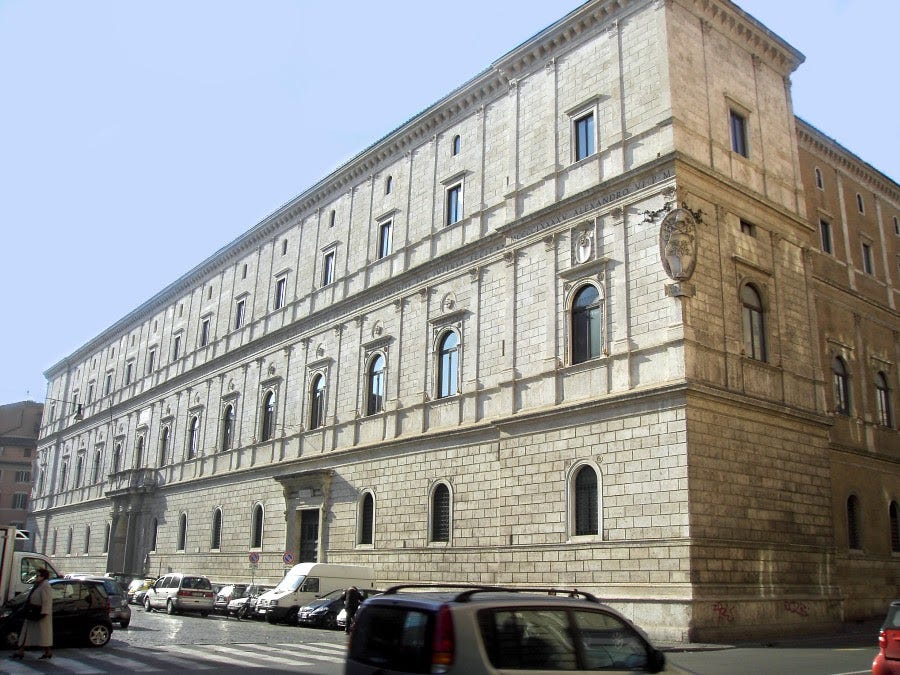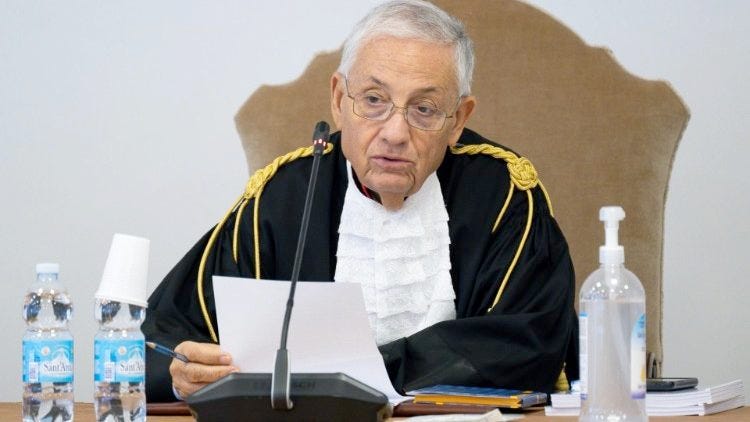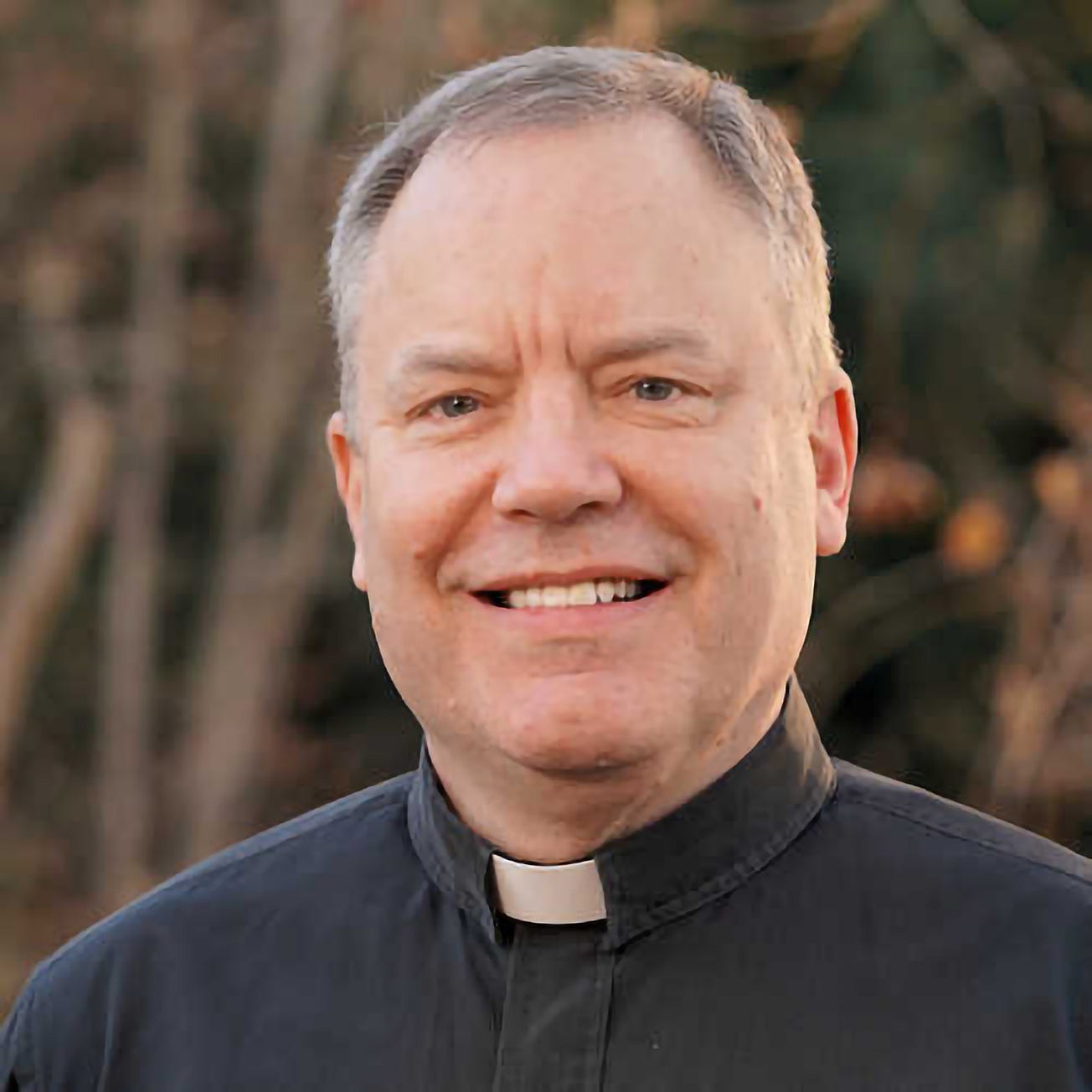The Church’s canonical court system has been in the news lately, and for a few reasons. The criminal trial of a cardinal in the court of the Vatican City State has made global headlines. And Catholics in the U.S. are praying this week for Cardinal Raymond Burke, who is reportedly in critical care treatment for the coronavirus, and who is the former head of one of the Vatican’s canonical courts — the Supreme Tribunal of the Apostolic Signatura.

To some Catholics, it probably comes as a surprise that a Church would have a court system at all. But a Church of more than 1 billion members, and with two millennia of history, has an entire legal system — with both local and universal laws, and local and universal courts to adjudicate disputes.
The supreme law of the Church is the salvation of souls. But if Catholics find themselves with disputes involving the Church’s other laws, these are the courts that address them:
Diocesan tribunals: Courts of first and second instance
While you might not know it, every Catholics diocese has its own canonical court, or tribunal.
Local tribunals are charged with hearing canonical cases involving disputes between ecclesiastical entities, like parishes or religious orders, with hearing cases involving penal matters, and with hearing marriage cases — petitions for declarations of nullity, or annulments.
In practice, nearly all of the work done by tribunals pertains to marriage.
With the exception of special cases which the Holy See insists on handling from the beginning (more on that to come), the local diocesan tribunal is expected, in principle, to be ready to hear and decide all kinds of cases. And it is expected to be equipped for that.
In addition to judges, local tribunals have prosecutors (called promoters of justice), special advocates who argue for the validity of marriages in annulment cases (called defenders of the bond), and are supposed to have a stable of canon lawyers available to recommend either to petitioners asking for a decree of nullity in a marriage case, or to defendants accused of violating canon law in the diocese (usually, but not always clerics). A shortage of canon lawyers means those roles are not all always filled, but they are called for.
Local diocesan tribunals are called “courts of first instance,” meaning they are the place where the Church’s legal system kicks in at the ground level.
Each diocesan tribunal also has a designated court of “second instance” - a court of appeal.
Traditionally, the designated court of second instance for a particular diocese is the tribunal of the local metropolitan archdiocese. That is the case in most of the United States.
But, especially as some formerly large urban archdioceses now have fewer resources, several dioceses sometimes come together and ask the Apostolic Signatura (see below) for permission to set up an independent regional second instance tribunal, towards which they all contribute.
The Tribunal of the Roman Rota
The Roman Rota is the Vatican appeals court for judicial processes throughout the global Church’s canonical system. Most of the cases it hears are final appeals in cases of marriage nullity, usually begun at the level of local dioceses, and then passed up through courts of second instance.
First established in the 12th century, the Roman Rota was also, until the creation of the modern nation of Italy in the 1800s, the civil high court for the Papal States.
Acting as the “supreme court” in most canonical judicial proceedings, the decisions of the Rota also become the jurisprudence cited by canonists making their arguments in lower courts.
The pope’s annual address to the judges of the court — called “prelate auditors” — is often used by the Holy Father to share his own visions for a particular point of legal interpretation or process.
The Rota is sometimes the court of first instance — so, not at the appellate level — for trials in which the defendant is a bishop of the Latin Church. Whether the canonical trial of a bishop goes to Rota depends on the nature of the crime. Canonical charges of bribery would go to the Rota, but certain major crimes, involving abuse of persons or sacraments, are reserved to the Congregation for the Doctrine of the Faith.
The Apostolic Tribunal of the Congregation for the Doctrine of the Faith
Canon law designates some of the most serious crimes, usually committed against the faith or the sacraments to the immediate judgement of the Holy See - with local diocesan tribunals unable to hear or prosecute the case. These are the worst crimes for which the Church has laws, like desecration of the sacred species of the Eucharist, violation of the seal of confession, and the abuse of minors.
Those canonical crimes are called “reserved delicts,” or crimes reserved to the judgement of Rome, and are defined by Pope St. John Paul II’s 2001 motu proprio Sacromentorum sanctitatis tutela, and a few subsequent amendments. The pope has stably delegated the prosecution of those cases to a special court at the CDF, called an Apostolic Tribunal because it works under the direct delegation of the judicial power of the Roman Pontiff.
The cardinal prefect of the CDF and the bishop-members of the congregation form the ordinary pool of candidates from which judges are assigned to cases. But it also can happen that judges, usually cardinals and bishops, are appointed specially to the tribunal to hear particular cases when special expertise in the law or local circumstances is needed.
The Apostolic Penitentiary
The Apostolic Penitentiary is a special tribunal that handles matters related to the “internal forum,” including things disclosed and discussed under the seal of confession.
Suppose a Catholic commits an act which is both a sin and a serious canonical, which comes with a canonical penalty attached. The act might be a priest who accidentally violates the seal of confession — talks about something he learned in confession — but in a way that has not become a matter of public scandal.
That priest might approach the sacrament of confession asking for absolution. And while his confessor might have the faculty to absolve the sin, he may not have the authority to lift a penalty, like an excommunication — so what does he do?
In those cases, the confessor would inform the penitent that he is going to contact the penitentiary on their behalf. In order to preserve the anonymity of the penitent, the confessor might arrange to meet him back in the same place on a certain date to give an update on the matter, so that it is never discussed outside of the confessional.
The confessor will then write to the penitentiary an account of the penitent’s circumstances, giving only as much description of the individual as is necessary to explain the situation, but under no circumstances identifying them, and requesting that the penalty be lifted. If more information is needed, the priest gathers it only under the seal of confession while continuing to ensure the anonymity of the penitent. When the penitentiary lifts the penalty, notification is sent to the confessor, who delivers it to the penitent in the confession and formally informs them that the penalty is lifted.
The Apostolic Penitentiary also has authority over the granting of indulgences in the Church, so, for example, if a diocese is celebrating a major jubilee and wants to grant pilgrims to the cathedral a partial indulgence, it is the penitentiary that grants permission.
The Supreme Tribunal of the Apostolic Signatura
Commonly called the Vatican’s “supreme court”, the signatura functions as a final court of appeal for cases decided by the Roman Rota.
But — and this is a big “but” — the Signatura does not rehear cases appealed from the Rota on the merits of the case — only procedural questions are considered. The court decides whether the Rota followed the rules of a proper trial, not whether its decision, if it did follow the rules, was a good one.
If procedural law wasn’t followed, the Signatura can vacate a Rotal decision and order a new hearing, but it cannot retry the case itself on the merits.
The Signatura is also the final court of appeal for administrative cases in canon law. Those cases usually involve appeals against some act of governance by the Vatican’s curial departments, or legal disputes between them.
If, for example, a bishop takes legal steps to close a church and suppress a parish, the parishioners can appeal, if they feel the proper steps were not taken and their rights were denied. That appeal goes to the Congregation for Clergy in the Vatican, which makes its own determination. If either the bishop or the people who appealed his initial decision are unhappy with the congregation’s decision, the case can be appealed to the Signatura, which has the final say on the case. (Except for the pope, who can theoretically intervene personally at any time.)
Similarly, if two congregations in the Vatican are in dispute about who should handle a particular case sent to them, the signatura can resolve the dispute.
The Signatura also acts as a final court of appeal for cases which come from the Vatican City’s civil courts, but more on that in a moment.
It’s also the job of the Apostolic Signatura to exercise “vigilance” over the administration of justice in the Church. In practice, this means the Signatura collects annual data from diocesan chanceries across the world, and assesses how well the wheels of justice are turning, how well staffed different courts are, and how well qualified legal practitioners are in different places.
Tribunal of the Vatican City State
While the terms “the Vatican,” “the Holy See,” and “the Roman curia” are often used as if they were interchangeable, they are not.
The Holy See is the sovereign entity under international law which, in the person of the pope, governs both the global Catholic Church and the territory of the Vatican City State. The Roman curia is the collection of departments that assist the pope in this work.
Vatican City itself a microstate in Italy, which is governed by the Holy See, and houses its offices, but is legally distinct.
The Vatican City State has a governariate, which handles the day-to-day administration of the territory as a microstate. The city also has its own separate legal code, including a criminal code, and its own criminal court.
While generally little known, the Vatican City’s criminal court has come to international attention in recent months, after Vatican City prosecutors charged ten people, including a cardinal, with a range of financial crimes.
The highest profile defendant in that case, Cardinal Angelo Becciu, was made to resign the rights and privileges of a cardinal by Pope Francis in September last year — a move that many saw as paving the way for the cardinal to be tried alongside his alleged co-conspirators.
At that time, cardinals accused of committing civil (as opposed to canonical) crimes in Vatican City were unable to be tried before the ordinary Vatican City court, instead, their cases would be heard by a specially constituted court from the Apostolic Signatura. But, earlier this year, Pope Francis issued a change to Vatican City law, allowing for cardinals accused of civil crimes in Vatican City to be prosecuted before the ordinary tribunal with papal authorization.



